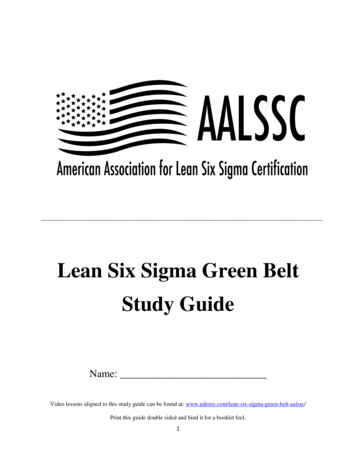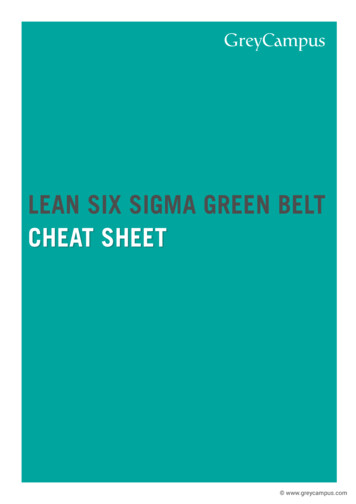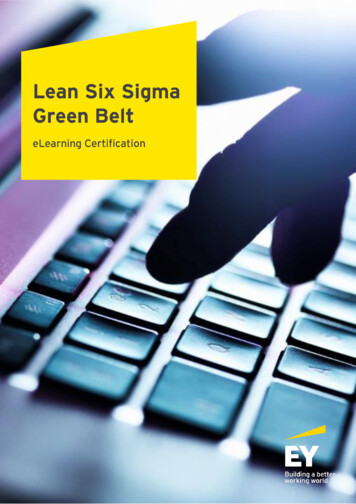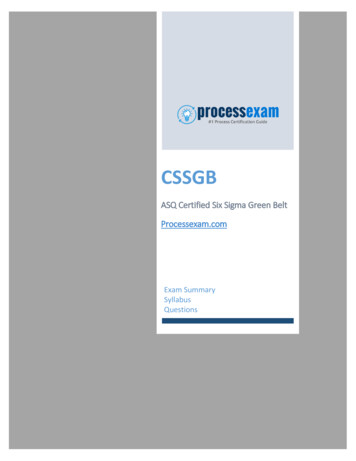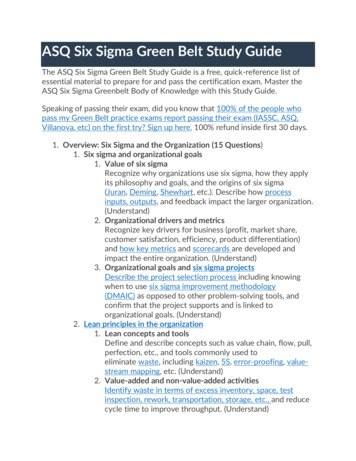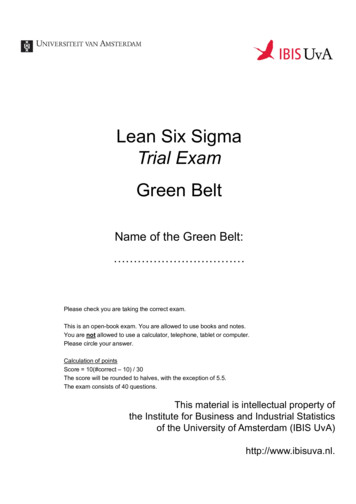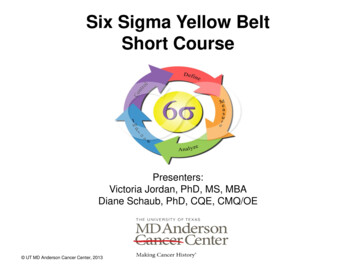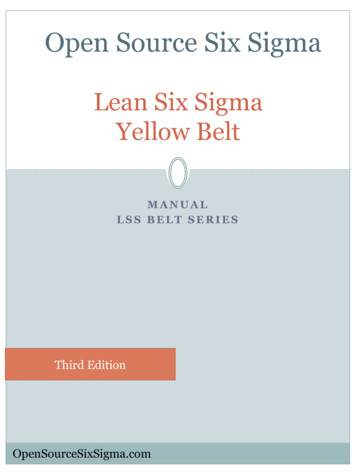
Transcription
CSSGBCERTIFIEDSIX SIGMA GREEN BELTQuality excellence to enhance your careerand boost your organization’s bottom lineasq.org/cert
Certification from ASQ is considered a mark of qualityexcellence in many industries. It helps you advance yourcareer and boosts your organization’s bottom line throughyour mastery of quality skills. Becoming certified as aSix Sigma Green Belt confirms your commitment to qualityand the positive impact it will have on your organization.ExaminationEach certification candidateis required to pass a writtenexamination that consists ofmultiple-choice questions thatmeasure comprehension ofthe body of knowledge.2Certified Six Sigma Green Belt
INFORMATIONCertified Six Sigma Green BeltThe Six Sigma Green Belt (CSSGB) operates in support or under the supervisionof a Six Sigma Black Belt, analyzes and solves quality problems, and is involvedin quality improvement projects. A Green Belt has at least three years of workexperience and wants to demonstrate his or her knowledge of Six Sigma toolsand processes.CSSGBExperience RequiredComputer Delivered - TheCSSGB examination is a one-part,110-question exam and is offeredin English only. 100 questions arescored and 10 are unscored. Totalappointment time is four-and-a-halfhours, exam time is 4 hours and18 minutes.Six Sigma Green Belts are employeeswho spend some of their time onprocess improvement teams. Theyanalyze and solve quality problems,and are involved with Six Sigma, lean,or other quality improvement projects.The Six Sigma Green Belt certificationrequires three years of work experiencein one or more areas of the Six SigmaGreen Belt Body of Knowledge. Workexperience must be in a full-time, paidrole. Paid intern, co-op, or any othercourse work cannot be applied towardthe work experience requirement.Educational waivers are not granted.Paper and Pencil – The CSSGBexamination is a one-part,100-question, four-hour examand is offered in English only.For comprehensive exam information on Six Sigma Green Belt certification,visit asq.org/cert.Certified Six Sigma Green Belt3
BODY OF KNOWLEDGECertified Six Sigma Green Belt (CSSGB)Topics included in this body of knowledge (BoK) are explanations(subtext) and cognitive levels for each topic or subtopic in thetest. These details will be used by the Examination DevelopmentCommittee as guidelines for writing test questions and aredesigned to help candidates prepare for the exam by identifyingspecific content within each topic that can be tested. Except wherespecified, the subtext is not intended to limit the subject or be allinclusive of what might be covered in an exam but is intended toclarify how topics are related to the role of the Certified Six SigmaGreen Belt (CSSGB). The descriptor in parentheses at the end ofeach subtext entry refers to the highest cognitive level at which thetopic will be tested. A complete description of cognitive levels isprovided at the end of this document.I. O verview: Six Sigmaand the Organization(13 Questions)A. Six Sigma andOrganizational Goals1. Value of Six SigmaRecognize why organizations useSix Sigma, how they apply itsphilosophy and goals, and theevolution of Six Sigma from qualityleaders such as Juran, Deming,Shewhart, Ishikawa, and others.(Understand)2. Organizational goals andSix Sigma projectsIdentify the linkages and supportsthat need to be establishedbetween a selected Six Sigmaproject and the organization’sgoals, and describe how processinputs, outputs, and feedbackat all levels can influence theorganization as a whole.(Understand)4Certified Six Sigma Green Belt3. Organizational driversand metricsRecognize key business drivers(profit, market share, customersatisfaction, efficiency, productdifferentiation) for all types oforganizations. Understand howkey metrics and scorecards aredeveloped and how they impact theentire organization. (Understand)B. Lean Principles in the Organization1. Lean conceptsDefine and describe leanconcepts such as theory ofconstraints, value chain, flow,and perfection. (Apply)2. Value stream mappingUse value stream mapping toidentify value-added processesand steps or processes thatproduce waste, includingexcess inventory, unusedspace, test inspection, rework,transportation, and storage.(Understand)
C. Design for Six Sigma(DfSS) Methodologies1. Road maps for DfSSDistinguish between DMADV(define, measure, analyze, design,verify) and IDOV (identify, design,optimize, verify), and recognizehow they align with DMAIC.Describe how these methodologiesare used for improving the endproduct or process during thedesign (DfSS) phase. (Understand)2. Basic failure mode andeffects analysis (FMEA)Use FMEA to evaluate a process orproduct and determine what mightcause it to fail and the effects thatfailure could have. Identify anduse scale criteria, calculate the riskpriority number (RPN), and analyzethe results. (Analyze)3. Design FMEA and process FMEADefine and distinguish betweenthese two uses of FMEA. (Apply)II. Define Phase (23 Questions)A. Project Identification1. Project selectionDescribe the project selectionprocess and what factors shouldbe considered in deciding whetherto use the Six Sigma DMAICmethodology or another problemsolving process. (Understand)2. Process elementsDefine and describe processcomponents and boundaries.Recognize how processes crossvarious functional areas and thechallenges that result for processimprovement efforts. (Analyze)3. BenchmarkingUnderstand various typesof benchmarking, includingcompetitive, collaborative, andbest practices. (Understand)4. Process inputs and outputsIdentify process input and outputvariables and evaluate theirrelationships using the supplier,input, process, output, customer(SIPOC) model. (Analyze)5. Owners and stakeholdersIdentify the process owners andother stakeholders in a project.(Apply)B. Voice of the Customer (VoC)1. Customer identificationIdentify the internal and externalcustomers of a project, and whateffect the project will have onthem. (Apply)2. Customer dataCollect feedback from customersusing surveys, focus groups,interviews, and various formsof observation. Identify the keyelements that make these toolseffective. Review data collectionquestions to eliminate vagueness,ambiguity, and any unintendedbias. (Apply)3. Customer requirementsUse quality function deployment(QFD) to translate customerrequirements statements into productfeatures, performance measures,or opportunities for improvement.Use weighting methods as neededto amplify the importance andurgency of different kinds of input;telephone call vs. survey response;product complaint vs. expeditedservice request. (Apply)C. Project Management Basics1. Project charterDefine and describe elements ofa project charter and develop aproblem statement that includesbaseline data or current status tobe improved and the project’sgoals. (Apply)2. Project scopeHelp define the scope of the projectusing process maps, Pareto charts,and other quality tools. (Apply)Certified Six Sigma Green Belt5
3. Project metricsHelp develop primary metrics(reduce defect levels by x-amount)and consequential metrics (thenegative effects that makingthe planned improvement mightcause). (Apply)4. Project planning toolsUse Gantt charts, critical pathmethod (CPM), and programevaluation and review technique(PERT) charts to plan projects andmonitor their progress. (Apply)5. Project documentationDescribe the types of data andinput needed to document aproject. Identify and help developappropriate presentation tools(storyboards, spreadsheet summaryof results) for phase reviews andmanagement updates. (Apply)6. Project risk analysisDescribe the elements of a projectrisk analysis, including feasibility,potential impact, and risk prioritynumber (RPN). Identify the potentialeffect risk can have on projectgoals and schedule, resources(materials and personnel), costsand other financial measures, andstakeholders. (Understand)7. Project closureReview with team membersand sponsors the projectobjectives achieved in relationto the charter and ensure thatdocumentation is completed andstored appropriately. Identifylessons learned and inform otherparts of the organization aboutopportunities for improvement.(Apply)D. Management and Planning ToolsDefine, select, and applythese tools: 1) affinity diagrams,2) interrelationship digraphs,3) tree diagrams, 4) prioritizationmatrices, 5) matrix diagrams,6) process decision programcharts (PDPC), and 7) activitynetwork diagrams. (Apply)6Certified Six Sigma Green BeltE. Business Results for Projects1. Process performanceCalculate process performancemetrics such as defects per unit(DPU), rolled throughput yield(RTY), cost of poor quality (CoPQ),defects per million opportunities(DPMO), sigma levels, andprocess capability indices. Trackprocess performance measures todrive project decisions. (Analyze)2. CommunicationDefine and describe communicationtechniques used in organizations:top-down, bottom-up, and horizontal.(Apply)F. Team Dynamics and Performance1. Team stages and dynamicsDefine and describe the stagesof team evolution, includingforming, storming, norming,performing, adjourning, andrecognition. Identify and helpresolve negative dynamics suchas overbearing, dominant,or reluctant participants, theunquestioned acceptance ofopinions as facts, groupthink,feuding, floundering, the rushto accomplishment, attribution,discounts, digressions, andtangents. (Understand)2. Team roles and responsibilitiesDescribe and define theroles and responsibilities ofparticipants on Six Sigma andother teams, including Black Belt,Master Black Belt, Green Belt,champion, executive, coach,facilitator, team member, sponsor,and process owner. (Apply)3. Team toolsDefine and apply team tools suchas brainstorming, nominal grouptechnique, and multivoting. (Apply)4. Team CommunicationIdentify and use appropriatecommunication methods (bothwithin the team and from the teamto various stakeholders) to reportprogress, conduct reviews, andsupport the overall success of theproject. (Apply)
III. Measure Phase(23 Questions)A. Process Analysisand DocumentationDevelop process maps and reviewwritten procedures, work instructions,and flowcharts to identify any gapsor areas of the process that aremisaligned. (Create)B. Probability and Statistics1. Basic probability conceptsIdentify and use basic probabilityconcepts: independent events,mutually exclusive events,multiplication rules, permutations,and combinations. (Apply)2. Central limit theoremDefine the central limit theoremand describe its significance inrelation to confidence intervals,hypothesis testing, and controlcharts. (Understand)C. Statistical DistributionsDefine and describe variousdistributions as they apply tostatistical process control andprobability: normal, binomial,Poisson, chi square, Student’s t,and F. (Understand)D. Collecting and Summarizing Data1. Types of data andmeasurement scalesIdentify and classify continuous(variables) and discrete (attributes)data. Describe and definenominal, ordinal, interval, andratio measurement scales.(Analyze)2. Sampling and datacollection methodsDefine and apply various samplingmethods (random and stratified)and data collection methods(check sheets and data coding).(Apply)3. Descriptive statisticsDefine, calculate, and interpretmeasures of dispersion and centraltendency. Develop and interpretfrequency distributions andcumulative frequency distributions.(Evaluate)4. Graphical methodsConstruct and interpret diagramsand charts that are designed tocommunicate numerical analysisefficiently, including scatterdiagrams, normal probability plots,histograms, stem-and-leaf plots,box-and-whisker plots. (Create)E. Measurement SystemAnalysis (MSA)Calculate, analyze, and interpretmeasurement system capability usinggauge repeatability and reproducibility(GR&R) studies, measurement correlation,bias, linearity, percent agreement, andprecision/tolerance (P/T). (Evaluate)F. Process andPerformance Capability1. Process performancevs. process specificationsDefine and distinguish betweennatural process limits andspecification limits, and calculateprocess performance metrics.(Evaluate)2. Process capability studiesDefine, describe, andconduct process capabilitystudies, including identifyingcharacteristics, specifications, andtolerances, and verifying stabilityand normality. (Evaluate)3. Process capability (Cp, Cpk)and process performance(Pp, Ppk) indicesDescribe the relationshipbetween these types of indices.Define, select, and calculateprocess capability and processperformance. Describe when Cpmmeasures can be used. Calculatethe sigma level of a process.(Evaluate)Certified Six Sigma Green Belt7
4. Short-term vs. long-termcapability and sigma shiftDescribe the assumptions andconventions that are appropriateto use when only short-term dataare used. Identify and calculatethe sigma shift that occurs whenlong- and short-term data arecompared. (Evaluate)IV. Analyze Phase(15 Questions)A. Exploratory Data Analysis1. Multi-vari studiesSelect appropriate sampling plansto create multi-vari study charts andinterpret the results for positional,cyclical, and temporal variation.(Create)2. Correlation and linear regressionDescribe the differencebetween correlation andcausation. Calculate thecorrelation coefficient andlinear regression and interpretthe results in terms of statisticalsignificance (p-value). Useregression models for estimationand prediction. (Evaluate)B. Hypothesis Testing1. BasicsDistinguish between statisticaland practical significance.Determine appropriate samplesizes and develop tests forsignificance level, power, andtype I and type II errors. (Apply)2. Tests for means,variances, and proportionsConduct hypothesis tests tocompare means, variances, andproportions (paired-comparisont-test, F-test, analysis of variance[ANOVA], chi square) andinterpret the results. (Analyze)8Certified Six Sigma Green Belt
Certified Six Sigma Green Belt9
V. Improve Phase(15 Questions)A. Design of Experiments (DoE)1. Basic termsDefi
4 Certified Six Sigma Green Belt I. Overview: Six Sigma and the Organization (13 Questions) A. Six Sigma and Organizational Goals 1. Value of Six Sigma Recognize why organizations use Six Sigma, how they apply its philosophy and goals, and the evolution of Six Sigma from quality leaders such as Juran, Deming, Shewhart, Ishikawa, and others.

